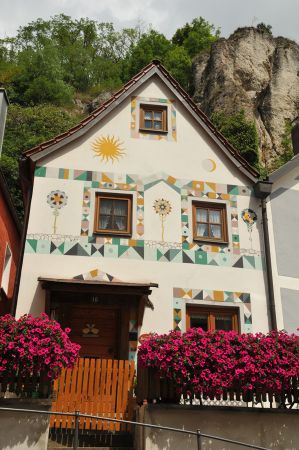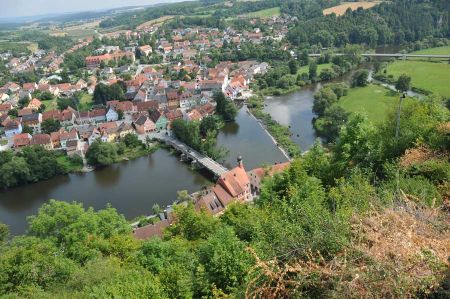Bike tour to Kallmünz - Camping Pielenhofen at Naab river
- Written by Portal Editor
As already announced, there should be further discussions about the German-Turkish literature and encounter festival in Regensburg, which also included the presentation of our project vehicle.
After short research and some local contacts, we decided to go to the campsite in Pielenhofen an der Naab. In addition to the immediate proximity to Regensburg, which can be easily reached by bike along the Naab and later the Danube, it was also the Naab itself and its immediate vicinity with its historic towns and castles that encouraged us in our decision.

Experience in handling the mover attached to the caravan made it easy to bring the vehicle into the desired position, which is sometimes difficult to manage with personal power alone due to the sloping terrain. The site was quickly set up, the satellite antenna aligned for internet access, so that the daily mail could be processed and initial contacts made with the neighbours, who of course were interested in the background of the project because of the Roman road maps on the caravan.

Thankfully, we had received a map from the reception on which the route, which was at least 17 kilometres long, had been drawn.
So we first reached Pielenhofen, then Kleinduggendorf, Grain am Berg and finally Kallmünz, whose name alone indicates a coin minting site.
Even the ride to Kallmünz was a relaxed bike ride with various breaks for photos and to view the wonderful flora and fauna along the Naab, a river system of various headwaters totalling 165 kilometres in length, whose water catchment area covers an impressive 5,225 square kilometres, with all the water flowing into the Danube flows.
During lunch in Kallmünz, we were able to talk to a river resident and victim of the last flood in detail.
At water levels of 5 meters, 24 hours' advance warning is hardly sufficient to secure belongings and also to make the building flood-proof. Due to its location between the two rivers Naab and Vils and the steep castle hill, the centre of Kallmünz is almost regularly hit by heavy flooding.
- Haidenaab: The right or western source river rises in the Fichtelgebirge.
- Waldnaab: The left or eastern and longest source river rises in the Upper Palatinate Forest.
- Fichtelnaab: A right or western tributary of the Waldnaab rises in the Fichtelgebirge.
- Schweinnaab: A right or western tributary of the Waldnaab. Source about ten kilometres northwest of Parkstein. Estuary in Weiden in the Waldnaab.
- Dürrschweinnaab: The smallest Naab. A right or western tributary of the Sauerbach, into which it flows at Altenstadt-Haidmühle. This is a left tributary of the Schweinnaab.
Over the late medieval stone bridge, which was built between 1549 and 1558, we cycle into the town centre. Unfortunately, parts of the stone bridge were damaged by ice in the 18th century and were even blown up by the Wehrmacht at the end of the World War in 1945, so that a modern reconstruction had to take place, which only slightly disturbs the character of the picturesque place.
Old houses with a new look, some of which are crowded under overhanging rocks, give the place a medieval ambience, which reaches its most famous highlight in the house without a roof right in the centre. Here a cave was converted into a house, the entire cave entrance was provided with a wall and associated doors and windows, giving the impression of a cave house comparable to the stone houses in Cappadocia.
The painter and professor Charles Johann Palmié, who had travelled from Munich, chose a newly opened inn in Kallmünz as his domicile in 1901 during his summer vacation. He also gave the inn the name "Zur Roten Amsel" and illustrated its exterior facade with his Munich friends al fresco.
The painters Wassily Kandinsky and Gabriele Münter became a couple here during their summer vacation in 1903. Kandinsky then developed a new style of painting, with which he turned away from representational painting and towards the abstract art of "colour tones" (as he put it).
Kallmünz soon became a scenically inspiring attraction for painters, who came here in increasing numbers and some of whom settled permanently. The artist colony soon numbered 38 painters.
Today's best-known painter from Berlin, Karl Schmidt Rottluff, was in Kallmünz in the fall of 1936. The important late Expressionist painter Josef Georg Miller lived in Kallmünz from 1944 until his death in a traffic accident. In 1944 he took over a pottery workshop with his wife Erna. After the Second World War, the artists ran a children's home.
From 1979 the painter Hans Geistreiter lived and worked in Kallmünz until shortly before his death. From autumn 1984 he had his own studio for large works. Today there are numerous galleries that show the works of local artists as well as those of guest artists. One can therefore speak of an artists' village without any problem.
Directly at the church, however, a steep path leads directly up to the castle ruins. Since the steps of this climb are very high, the alternative path at the end of the village is better for children or older visitors, which is longer in loops but much more comfortable.
After the ascent you reach the breakthrough through the castle wall and get into the extensive areas of the complex. If you have chosen the alternative route, you can reach the inner courtyard directly through the Great Castle Gate.
About 1000 meters before the spur tip, a two-phase outer section wall runs over the Hirmesberg, which dates from the Middle Bronze Age around 1600 BC. B.C., and about 100 meters in front of the medieval castle complex, there was also a multi-phase inner section wall from the La Tène period around 500 B.C. BC, which was later built over by the "Hungary Wall". This protective wall, which is still popularly known today as the "Hungary Wall", was probably intended to serve as a retreat for the local population during the Hungarian invasions in the 10th century.
There were many other interesting details in the castle complex, which would go beyond the scope of this article. However, all those who are interested should be told that the way up to the castle complex is always worthwhile, especially since the view of the town of Kallmünz and the confluence of the Naab and Vils with the colours of the surrounding forests is really impressive. Colours and shadow situations change depending on the position of the clouds and the position of the sun, even the reflections on the water are impressive. Accordingly, we lingered for a while on a bench directly above the city, which offered this wonderful view.
Please read as well:
Animal welfare: Mistreatment be punished with high fines!
Omis - adrenaline fun in a spectacular canyon landscape
https://www.alaturka.info/en/bicycle-travelling-e-bike-camping/6247-bike-tour-to-kallmuenz-camping-pielenhofen-an-der-naab/amp#sigProId09373e3385
